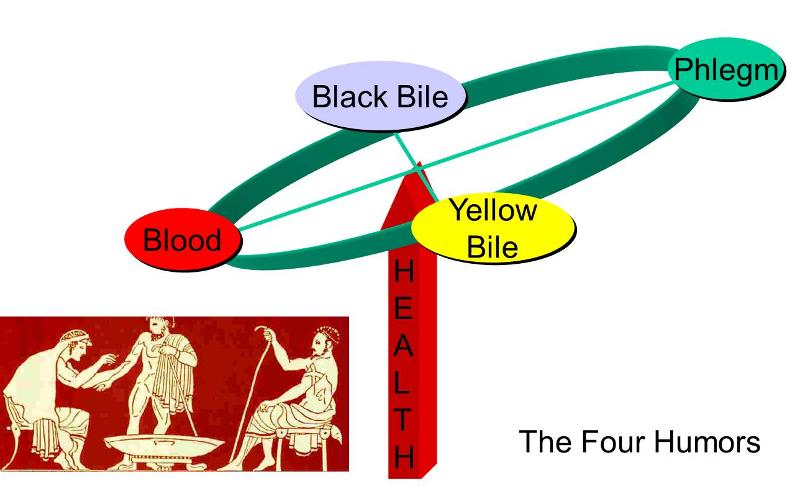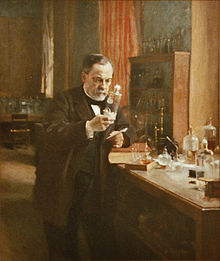Historical Views of Causation
Four Vital Humors
Historically, there have been many efforts to account for the occurrence of disease outcomes. Religions often attributed disease outbreaks or other misfortunes to divine retribution - punishment for mankind's sins. Hippocrates promoted the concept that disease was the result of an imbalance among four vital "humors" within us:
- Yellow Bile
- Black Bile
- Phlegm
- Blood
Hippocrates believed that if one of the humors became excessive or deficient, health would deteriorate and symptoms would develop. Hippocrates was a keen observer and tried to relate an individual's exposures (e.g., diet, exercise, occupation, and other behaviors) to subsequent health outcomes.

Consequently, his recommendations and "prescriptions" were often based on his observations and his perception of cause and effect. His disease model, however crude, also suggested seemingly logical interventions. For example, if he surmised that an individual suffered from too much of the humor "blood", he prescribed blood letting to alleviate the problem. The scene depicted to the right shows a female physician in the process of letting blood from one of her patients.
Miasmas
Another popular theory that persisted until the end of the 19th century was that miasmas were responsible for disease. Bad odors were equated with disease. Miasmas were toxic vapors or gases that emanated from cesspools or swamps or filth, and it was believed that if one inhaled the vapors, disease would result. This theory provided an explanation for outbreaks of infectious disease, including cholera and plague. As a result many ineffective interventions were pursued. Bonfires and smoking urns were used to prevent both plague and cholera. In the 14th century "plague doctors" wore masks with beak-like projections filled with aromatic herbs in order to counteract the effect of miasmas. Echoes of the miasmatic theory can be found in the name "malaria", derived from the Italian for "bad air" (mala, aria). It reflects the correct observation that the disease was more common in swampy areas, but it misidentified the cause as the foul odors rather than the bacterium caused by the mosquito that bred there.
were responsible for disease. Bad odors were equated with disease. Miasmas were toxic vapors or gases that emanated from cesspools or swamps or filth, and it was believed that if one inhaled the vapors, disease would result. This theory provided an explanation for outbreaks of infectious disease, including cholera and plague. As a result many ineffective interventions were pursued. Bonfires and smoking urns were used to prevent both plague and cholera. In the 14th century "plague doctors" wore masks with beak-like projections filled with aromatic herbs in order to counteract the effect of miasmas. Echoes of the miasmatic theory can be found in the name "malaria", derived from the Italian for "bad air" (mala, aria). It reflects the correct observation that the disease was more common in swampy areas, but it misidentified the cause as the foul odors rather than the bacterium caused by the mosquito that bred there.
Germ Theory - Koch's Postulates
Even though there was a "germ" of truth in miasmatic theory, in that it focused attention on environmental causes of disease and partly explained social disparities in health (poor people being more likely to live near foul odors), the theory began to fall into disfavor as the germ theory gained acceptance. Louis Pasteur and others introduced the germ theory in 1878.

In 1890 Robert Koch proposed specific criteria that should be met before concluding that a disease was caused by a particular bacterium. These became known as Koch's Postulates, which are as follows:
- The bacteria must be present in every case of the disease.
- The bacteria must be isolated from the host with the disease and grown in pure culture.
- The specific disease must be reproduced when a pure culture of the bacteria is inoculated into a healthy susceptible host.
- The bacteria must be recoverable from the experimentally infected host
Koch's postulates established standard criteria for drawing conclusions about the cause of infectious disease, but the criteria obviously don't apply to non-infectious diseases. In addition, the criteria also had some limitations even with respect to infectious disease. For example, not all infectious diseases have good animal models. Another problem was that bacteria that we regard as "normal flora", such as the Staphylococcus aureus on our skin, are generally harmless but can cause disease under certain conditions. Moreover, when people are exposed to a bacterium, such as the TB bacillus, they don't necessarily become infected. There appear to be many other factors that play a role in determining whether a given individual becomes infected after they are exposed. Factors such as nutritional status or immune status clearly have an impact in "causing" TB, but all these other determinants aren't accounted for by Koch's postulates.
Webs of Causation
The germ theory obviously didn't provide insights regarding the causes of chronic diseases, and over time it became increasingly apparent that for most diseases there were many contributory factors. Researchers began thinking about complex "webs" of causation. The image below summarizes a web of causation for obesity in the context of a socio-ecologic perspective. Note that some factors are more "proximate" or immediate, such as decreased energy expenditure and increased food intake, while other factors or perhaps root causes are more distal, such as globalization of markets, development, and advertising.

Image source: http://www.endotext.org/obesity/obesity22/obesityframe22.htm


